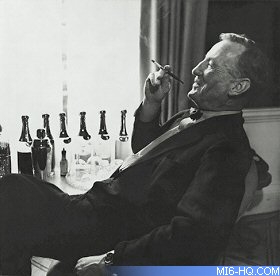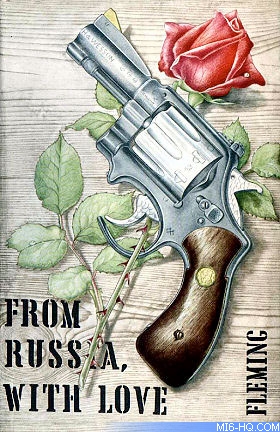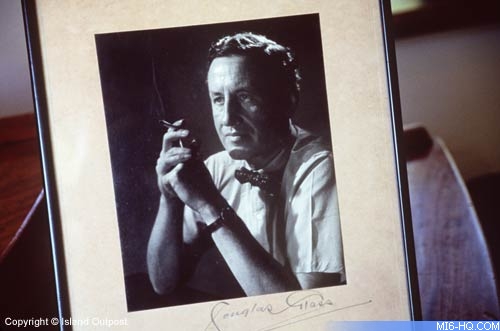 |
| |
MI6 traces the legacy of the Ian Fleming's James
Bond novels and their parallels to modern culture
and
politics...
|
|
James Bond In History (1)
17th June 2008
James Bond, the infamous secret agent, has had
immense popularity and sustainability as both a character and
a pop-icon. Over the
past 50 years, the persona of James Bond has influenced fashion
and style, movies and television, art and even the way people
behave.
To track James Bond through the decades is a
massive task, but when searching the giant realm of these classic
spy-thrillers
it is not hard to see where Bond has left his mark or to find
parallels with our 20th century culture and politics. With the
spirit of celebrating the centenary of Ian
Fleming's birth in mind, MI6 tracks the legacy of 007 as
an icon in the modern world.
Spotting the Differences
Leaving aside the statement that Ian Fleming's creation
is a parallel for modern life; there clearly was a time
when Bond was not about. Indeed before the year of 1953
there was no Bond - guns were agents of evil and sex
was something kept well behind closed doors. Gritty heroes
drank black coffee and battled their evils with words, not
actions.
James Bond developed as a spark
in the mind of creator Ian Fleming during his time in the
forces. Although he never saw action as Bond did, Fleming
was inspired to pen this extravagant character after a
spell
in the secret office of the British navy.
But it was not the "who" that Fleming was fixated
with, but the "what" and "how". Never
did Fleming expect "the man with the boring name"
to explode into a household legend and a time-changing
character - he simply wished to write entertaining spy
stories.
|
|

Above: Author Ian Fleming relaxes at his Jamaican home, Goldeneye |
Fleming created a character that seemed quite natural to his
eccentricities of the time. He crafted someone he could personally
idolise. James Bond held the figure later to be associated with
the 1960's playboy - a smoking, drinking, womanising,
cold-hearted rogue. A modern gentleman, but perhaps a century
too early.
 Above: Bond gets caught in a twisted SMERSH plot in Fleming's fifth 007 adventure... Above: Bond gets caught in a twisted SMERSH plot in Fleming's fifth 007 adventure...
|
|
A Relic of the Cold
War
Fleming thought nothing of labeling his enemies. At the
time, it was "clear" to
the West that the biggest threat to the civilised world
lay in the East. From the frequency of rumours
it wasn't unreasonable
for Fleming to craft the sadistic Russian organization
known as SMERSH who operated under the motto, "Death
to Spies".
Since the end of the War in '45,
the world was split down the middle. The Western world
began to identify new threats and anti-communist propaganda
spread freely throughout the UK and America. The words
"Stalin", "evil" and "nuclear"
were household terms and the West was poisoned with the
idea of a Russian threat. With the surrounding anger,
it was reasonable for Fleming to associate his villains
and their master plans with the stereotype of the "Evil-East".
James Bond was born in a time of suspicion, fear, and
loathing for the unknown.
The 1950s were the heart of the Cold War - yet 1954,
the year of "Casino
Royale", saw some restructuring within both Russian
and US politics. On the death of Stalin in '53, Nikita
Khrushchev took up the presidency of the Soviet Union and in
the same year President Eisenhower - the first Republican
in 20 years - took up the Oval Office in America.
|
|
Above: Presidents Khrushchev & Eisenhower
|
Both leaders brought a fresh change to their
respective ideals - Khrushchev denouncing many of Stalin's
internal policies and Eisenhower helping to bring an end to American
involvement in Korea. Nevertheless, it took another 20 years
for the
Western culture (and indeed James Bond) to begin make peace with
the Eastern Superpowers. A lot of blood and pride can be lost
in 20 years.
A New Spy for a New
World
James Bond was successful and enduring, iconic and some
might say invincible - but he was not born with this
status. Granted, he grew quickly to become the most, if
not profitable, then unarguably successful series ever.
Some might argue James Bond began in London,
when "Casino Royale" hit the printers. Others
say it was in Jamaica, when Fleming typed out those first
famous words. But the concept of Bond actually began in
1944, when on the side of the road in Cherbourg, France,
Fleming was asked about his post-war plans. It was here
that Fleming announced he would write "the spy story
to end all spy stories" and the pretext of Special
Agent 007 was born.
But it was not enough for Bond just to
exist. He had to be popular too. His popularity extended
from the fact he was an anti-hero - a startling change
from anything in fiction before or since. Bond set the
standards
for action, adventure and most controversially, brutality.
"Casino Royale" was released
to satisfactory sales in the UK and many reporters
paralleled Fleming to the already successful Raymond
Chandler,
author of the Philip Marlowe detective series. Fleming
and Chandler would later become good associates, sharing
a knowledge for the literary business. |
|

Above: Cover art for first edition Fleming novel, "Casino
Royale", designed by Ian Fleming himself... |
In 1954, "Royale" entered the USA
to slimmer success - the up-market nature of 007 not proving
as popular among the Americans. Fleming, never very positive
about his first novel, distributed it to associates in the US
baring
the inscription: "read and burn." Bond's success
in the US took the pulp-paperback publishers Popular Library
to release "Casino Royale" under the name "You
Asked For It". Fleming found his niche and successfully
sparked a love for spy-thrillers in both the US and UK.

Above: Modern day GoldenEye is still host to Fleming's
writing desk and memorial photo
|
Fleming was a stubborn man and so on his annual
return to Jamaica, set about writing "Live
And Let Die".
It continued year by year, Fleming returned to GoldenEye,
his Jamaican estate and "banged" out a Bond adventure
each year.
Stay tuned to MI6 for the second
part of "James Bond in History" when we look back at the
legacy of the on-screen legend...